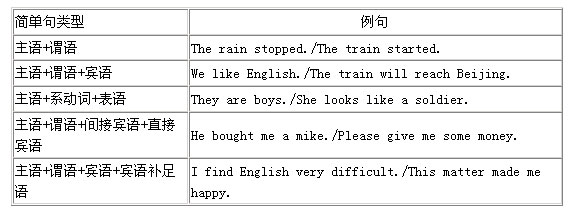| 高二英语辅导:动词为突破口句意表达一路走 |
| http://www.sina.com.cn 2004/10/25 16:20 英语辅导报 |
句子是书面表达的基本单位,因此书面表达实际上就是特定语境中句意的表达。句意表达的方法和技巧很多,本文谈谈如何以动词为突破口进行句意表达。 一、 弄清成分顺序,确定句子结构 众所周知,句子成分顺序的表达有如下表所示的五种基本句型。
 由以上表达可清楚看出,简单句五种基本句型中均含有谓语动词,而且谓语动词位于句子中间,并起着连接主语和宾语/表语的作用,因此,以动词为突破口可以巧记动词前后成分,从而正确把握句子的结构。 二、 分析各种一致进行句意表达 动词是任何句子不可缺少的成分,它与其它多种成分之间存在着内在联系,形成各种一致。分析这些一致可以巧妙地进行句意表达;反之,如果打破这些一致性,句意的准确表达就难以得到保证。 1. 分析主谓搭配进行句意表达 例1: 尽管他的邻居们过去对他很友好,但现在不喜欢他。 误: His neighbor don't like him now though they used to be kind to him. 正: His neighbors don't like him now though they used to be kind to him. 例2: 任何人都可以借书,而且借书不花钱。 误: Anyone may borrow books, and it cost nothing to borrow them. 正: Anyone may borrow books, and it costs nothing to borrow them. 例3:现在我的照片和奖状就挂在图书馆里。 误: Now my picture and the prize is hanging in the library. 正: Now my picture and the prize are hanging in the library. 析:表达句意时应认真分析主语和谓语的单复数,根据主谓一致的原则配之以单复数形式正确的名词和动词。 2. 分析动形搭配和动副搭配进行句意表达 例1: 他对他的学生要求严格。 误: He is very strictly with all his students. 正: He is very strict with all his students. 例2: 请专心致志地听英语老师讲课。 误: Please listen to your English teacher attentive. 正: Please listen to your English teacher attentively. 析:表达句意时应注意修饰连系动词用形容词,修饰行为动词用副词。 3. 分析动介搭配进行句意表达 例1: 他们把全班分成两个组。 误: They divided the class in two groups. 正: They divided the class into two groups. 例2:据说病人在医院里得到很好的照料。 误: It is said that the patient is being well looked for in the hospital. 正: It is said that the patient is being well looked after in the hospital. 析:表达句意时应注意分析动词和介词的搭配是否正确。 4. 分析动词与时态搭配进行句意表达 例1:如今保持身体健康比过去容易得多了。 误: Today it is much easier to be healthy than it is in the past. 正: Today it is much easier to be healthy than it was in the past. 例2: 过去在业余时间我常打乒乓球,但现在我对足球感兴趣。 误: I use to play ping-pong a lot in my spare time, but now I am interested in football. 正: I used to play ping-pong a lot in my spare time, but now I am interested in football. 例3: 我想起了她的话冷静了下来。 误: I remembered her words and calm down. 正: I remembered her words and calmed down. 析:表达句意时应借助于特定语境、特定时间状语或特定时态的提示而采用正确的时态,并在动词形式上准确体现。 5. 分析动词与主语之间的主动与被动搭配,进行句意表达 例1: Charles和Linda被发现到了楼顶。 误: Charles and Linda were seeing near the top of the building. 正: Charles and Linda were seen near the top of the building. 例2:图书管理员会给你写信,让你知道你要的书已被归还。 误: The librarian will write to you, and let you know when the book you want has returned. 正: The librarian will write to you, and let you know when the book you want has been returned. 析:表达句意时应分析主语和动作的执行与承受、主动与被动关系,从而使用正确的语态。 三、分析动词变化形式确定句式类型 动词是最重要的词类,几乎所有特定句式均以动词的变化为标志,因此分析动词形式变化可以确定句式类型,反之表达特定句式需对动词作特定变化,请看下列历年高考英语书面表达例句,体会特定句式在动词形式上的变化规律。 [高考题例] 例1: You know where that is, don't you? 析:陈述句变成反意疑问句时,附加疑问句部分应由"肯定或否定式助动词+主语"构成。 例2: I'm sure you'll have no trouble finding us. Do come! 析:在祈使句中就动词原形进行强调时,应在动词原形前面加强调词do。 例3: The flat is in a building on Fangcao Street, which is not far from Jianxin Chinese School. 例4:"We've found you at last," they said. But we didn't know them. 例5: The car didn't stop but drove off at great speed heading west. 例6: I don't know about others ... 析: 陈述句变成否定句时,应在助动词后面加not或将实义动词改成"do / does / did not +实义动词"。 例7: Hope you don't have to wait as long as we did. 例8: Don't forget: 7:30, Saturday evening, roof garden, Main Building. 析:祈使句应以动词原形(否定句以助动词Don't)开头。 例9: Do you think you'd like it? 析:一般疑问句应以助动词开头。 (文/郝昌明; 英语通高二版 04~05学年度第8期;版权归英语辅导报社所有,独家网络合作伙伴新浪教育,未经许可,不得以任何形式进行转载。) |
|
|
|
|
|
| Annotation |
| 新闻查询帮助 | |
| 热 点 专 题 | ||||
| ||||
|
教育频道意见反馈留言板 电话:010-62630930-5178 欢迎批评指正
新浪简介 | About Sina | 广告服务 | 联系我们 | 招聘信息 | 网站律师 | SINA English | 会员注册 | 产品答疑
Copyright © 1996 - 2004 SINA Inc. All Rights Reserved
版权所有 新浪网![]() 北京市通信公司提供网络带宽
北京市通信公司提供网络带宽